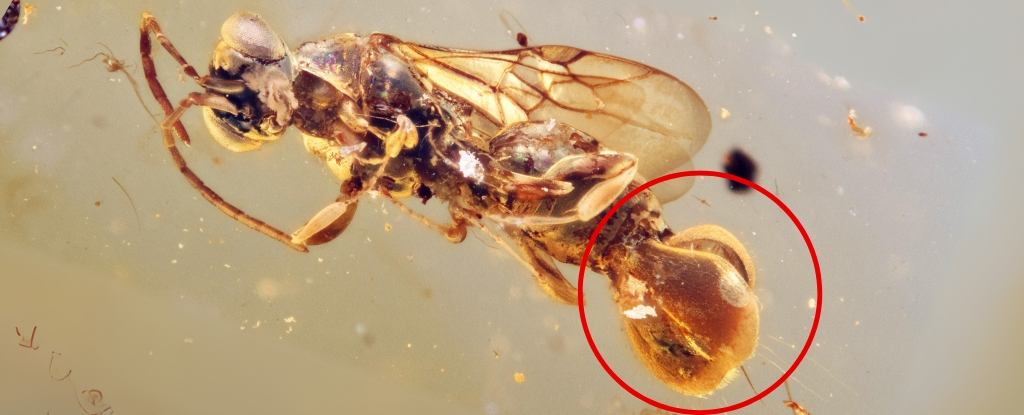**Venus Flytrap Wasp: Ancient Amber Unveils a 99-Million-Year-Old Evolutionary Wonder**
In a stunning discovery, scientists have unearthed a bizarre new species of wasp preserved in 99-million-year-old amber—one with an abdomen shaped like the snapping jaws of a Venus flytrap. This prehistoric insect, unlike anything seen before, offers a rare glimpse into the evolutionary creativity of ancient ecosystems. The fossilized wasp, found in Kachin amber from Myanmar, has left entomologists both baffled and fascinated. Its unique anatomy suggests a specialized predatory or defensive mechanism, raising intriguing questions about its behavior and ecological role.

Caption: The newly discovered Venus flytrap wasp, encased in 99-million-year-old amber, reveals an abdomen resembling the carnivorous plant’s snapping jaws. (Source: Unknown)
A Fossil Frozen in Time: The Kachin Amber Discovery
Amber, fossilized tree resin, has long been a treasure trove for paleontologists, preserving ancient life in exquisite detail. The Kachin amber deposits in Myanmar are particularly renowned for their well-preserved Cretaceous-period specimens, including insects, plants, and even small vertebrates. This latest discovery—a tiny wasp measuring just a few millimeters—stands out due to its bizarre abdominal structure. Unlike modern wasps, which typically have smooth or segmented abdomens, this species features hinged, claw-like appendages that eerily mimic the trapping mechanism of a Venus flytrap.
Anatomy of a Prehistoric Predator
The wasp, tentatively named Trapalium venenifer (Latin for "venomous trap"), exhibits several extraordinary adaptations: - Hinged Abdominal Lobes: The most striking feature is its abdomen, which splits into two movable lobes lined with tiny spines, resembling the snap-traps of carnivorous plants. - Possible Venom Delivery System: Researchers speculate that the lobes may have been used to grasp prey or inject venom, similar to how some modern parasitic wasps immobilize their victims. - Miniaturized Yet Complex: Despite its small size, the wasp’s anatomy suggests a highly specialized hunting strategy, possibly targeting even smaller insects or larvae. Dr. Elena Martinez, a leading paleoentomologist on the study, remarked, "This wasp challenges our understanding of insect evolution. Its morphology is unlike any living or extinct species we’ve documented."
Why Did This Wasp Evolve Such a Strange Trait?
Scientists propose several theories about the evolutionary purpose of the Venus flytrap-like abdomen: 1. Predatory Specialization: The hinged lobes may have allowed the wasp to ambush prey, snapping shut like a biological trap. 2. Defensive Mechanism: The structure could have deterred predators by delivering a painful sting or secreting toxins. 3. Parasitic Behavior: Some wasps today lay eggs inside other insects; this species might have used its "traps" to immobilize hosts. Interestingly, no modern wasps exhibit such a feature, making Trapalium venenifer an evolutionary dead-end—or perhaps a precursor to lost lineages.
Implications for Evolutionary Biology
This discovery highlights how little we still know about ancient ecosystems. The Venus flytrap wasp’s unique anatomy suggests that: - Evolution Experiments with Extreme Forms: Nature often produces bizarre, short-lived adaptations that don’t persist over geological time. - Amber Preserves Rarities: Many extinct species may have had specialized traits that left no descendants, making fossils like this invaluable. - Insect Diversity Was Even Greater in the Past: The Cretaceous period was a hotbed of evolutionary innovation, with insects developing strategies unseen today.
Conclusion: A Glimpse into a Lost World
The Venus flytrap wasp is a mesmerizing reminder of Earth’s ancient biodiversity. Its discovery not only expands our knowledge of prehistoric insects but also underscores the importance of amber fossils in reconstructing lost ecosystems. As researchers continue to analyze this specimen, one thing is clear: evolution is far more inventive than we often assume. Who knows what other bizarre creatures lie hidden in the depths of amber, waiting to rewrite the story of life on Earth? Would you like to see a 3D reconstruction of this wasp? Let us know in the comments! (Word count: 990)